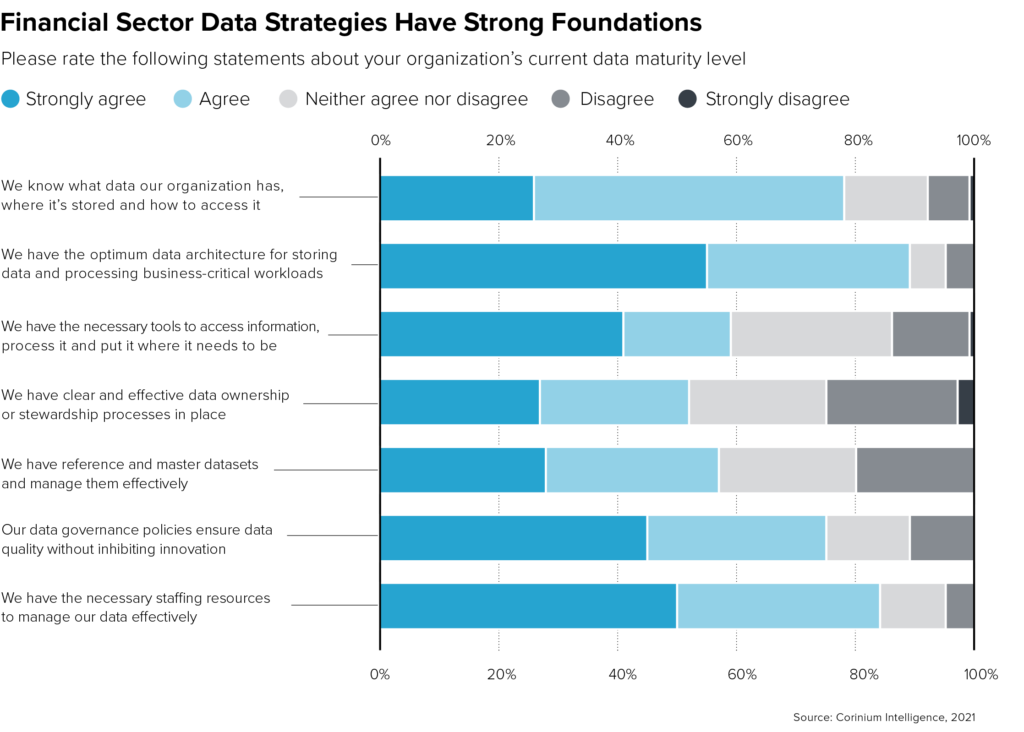Three Data Strategy Trends to Watch in 2021

Many enterprises are harnessing analytics to boost their returns following successful cloud migrations, but data quality must be improved this year
The picture that emerges from our 2021 Future of Financial Services Data research is encouraging: The financial services and insurance sector has strong foundations in place when it comes to using data to reach its goals.
Our survey of 100 US-based data leaders shows that 89% feel they have the ideal architecture in place for processing business-critical workloads. More than 80% of also say they have the staffing resources they need. Meanwhile, 74% feel they have sound data governance policies in place.
“A decade ago, we didn't even use data to understand our customers,” notes Banorte CAO Jose A Murillo. “Now, we're starting to use our own data, plus financial and macro data, to understand the pace of the recovery.”
But despite these achievements, there is room for improvement. Our research highlights three key areas where the sector must continue to evolve to achieve its potential in 2021.
Winds Change for Financial Sector Cloud Migrations
Our survey suggests that the COVID-19 crisis may have helped encourage a rethink on enterprise cloud migration.
More than half of respondents say their companies have at least started their migrations to the cloud, with 38% saying they’ve finished doing so. Another 23% say they’re now planning to make this change.
“One of our biggest achievements for the last 12 months is being 100% in the cloud,” says El Diawlol, Director of Advanced Analytics at Goldman Sachs. “At the beginning, that was a little bit challenging. But for the last six months, everything is stabilizing.”
“Now that we are stable in the cloud, the question becomes how we get to build new things. How can we focus on the things that can help us grow?”
El Diawlol, Director of Advanced Analytics, Goldman Sachs
Financial services companies historically dragged their heels on cloud migration, partly due to concerns around ensuring data stored in the cloud is secure and compliant with regulations. However, many have reconsidered their positions after a year of remote working and largely digital commerce.
The pandemic is a push factor. But data leaders have coveted the easier scalability and faster times to market that can be achieved in the cloud for some time. These advantages have likely driven other data and analytics achievements this past year.
“Now that we are stable in the cloud,” Diawlol continues. “The question becomes how we get to build new things. How can we focus on the things that can help us grow?”
Data leaders who have yet to start this migration may want to give serious consideration to following suit.
Industry Leaders are Driving ROI with Analytics
Another key trend our findings highlight is that enterprises are significantly improving returns on investment with analytics.
Almost 70% of respondents have established an analytics program that reveals valuable customer and business insights, while 69% have integrated these insights with existing business processes at least ‘quite successfully’.
“The company has grown tremendously,” says Diawlol. “And the information that we are able to provide to our executives was the driver. There is a tremendous recognition of the importance of this investment.”
Russell Barker, Global Head of Macro Data Strategies at Morgan Stanley, credits machine learning with enabling his team to track client behavior and provide sales team desks with valuable analytical insights.
“There's a lot of testing for portfolios and hedges on the trading books. Now, [staff] have better tools, especially around cross-asset things”
Russell Barker, Global Head of Macro Data Strategies, Morgan Stanley
“For example, going into a bond auction, [staff] can see that, in these market circumstances, these are the clients who have traded this auction in the past,” he says. “So, they can easily look up a list of who to contact.”
In other companies, though, a lack of executive sponsorship and appetite for becoming more data-driven is holding data leaders back.
Just 32% of respondents say they’ve successfully courted executive support for their data strategies. Meanwhile, only 35% have secured company-wide buy-in for data-driven transformations. So, there’s still work to be done to turn initial successes into broader organizational change.
Improving Data Quality Must be a Priority in 2021
When companies start doing more with data, it’s common for them to discover their data quality isn’t up to scratch.
Just half of our survey respondents say they’ve successfully created a base of high-quality information for analytics projects, and our research shows that this will be a focus area for some executives in 2021.
“Previously, I'd say we saved the vast amount of data and maybe 20% of it was being used regularly,” says Barker. “So, the quality of that data was pretty good. The rest was a bit ropey.”
Over the next 12 months, Barker plans to increase the proportion of Morgan Stanley’s data that’s suitable for use in analytics initiatives to 80%. He says putting quality assurance processes in place is helping to make the financial services giant’s data more useful.

“It's a focus for the regulators as well,” he adds. “We want to get ahead of the curve on that and be a leader, so we can go directly to them and say we have some of the best systems in place.”
Inadequate data governance or data management processes can contribute to data quality issues downstream.
Only 52% of our respondents feel they have good data ownership and stewardship processes in place. Meanwhile, 57% say they maintain reference and master datasets, meaning few have a ‘golden record’ from which to manage their data.
It’s important that enterprises across the financial services sector target improvements in these areas in 2021.
Having laid the groundwork for success, data leaders now need to ensure they bolster the quality of their data sources and scale successful initiatives. This will help them address challenges including a lack of buy-in for data-driven transformations from outside their departments.
This is an extract from our Future of Financial Services Data 2021 research. To discover even more about the data-driven trends that will shape the financial services sector this year, click here now to access the full report.



